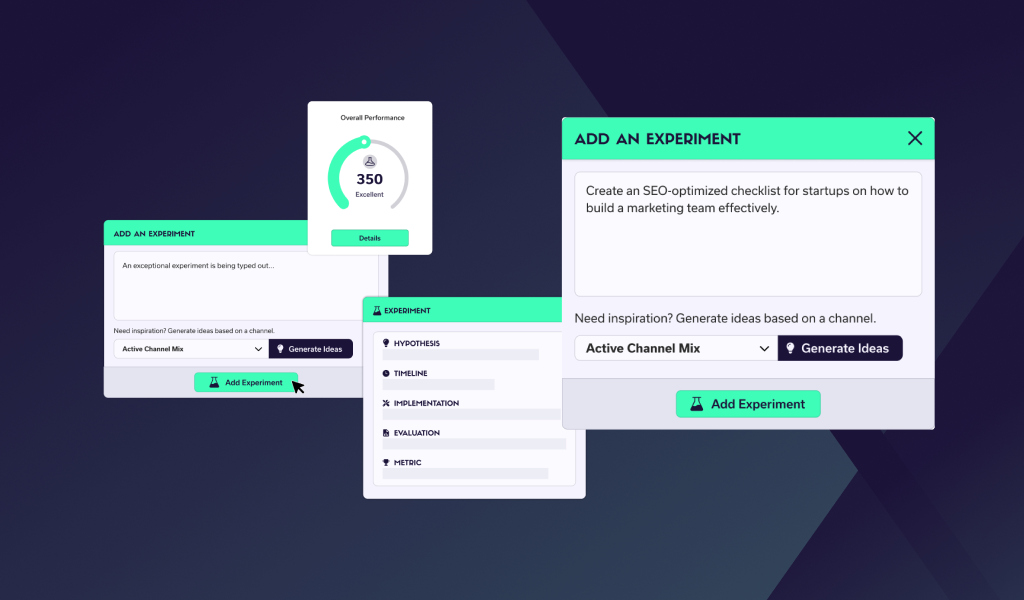Marketers have, let’s face it, a bit of a bad rep when it comes to jargon. New terminology to describe existing concepts comes in and out of fashion all the time. Miss a Zoom call and you may have missed the genesis of 3 or 4 new bits of jargon - everyone will start using them, and you’ll feel like a loser who doesn’t know the latest slang.
You might be forgiven for thinking that ‘growth marketing’ belongs to this category. After all, your understanding of the function of ‘marketing’ probably involves, to a significant extent, the attraction of new customers and therefore the growth of the business.
Growth marketing, however, is not jargon. It describes a process that overlaps some traditional marketing activities, but it’s distinct - it’s a different mindset, a different focus, and has different goals.
In this blog we’re going to lay out a definition that can help you understand what growth marketing is, what it’s for and why it’s different from the traditional marketing function.
What is growth marketing?
At its core, growth marketing is the data-led process of running experiments to grow and engage the customer base. Growth marketers are constantly looking for ways to impact on two metrics:
Lifetime User Value (LTV)
Maximising the average value a customer or client generates for the business. This can mean anything from getting the audience segmentation and targeting right (so you’re attracting the right kind of people), to encouraging your current customer base to engage more with the brand through email marketing and social media. Every part of the marketing funnel can affect LTV, so growth marketers look at every part of the funnel for weaknesses and opportunities.
Customer Acquisition Cost (CAC)
How much your business spends to acquire each new customer. Affected by everything from targeting, to creative, to channel selection, to on-site or in-app experience. This, perhaps, is what you more closely associate with the marketing function (although, traditional marketers would probably say they work on LTV too). It’s about winning new business without over-paying for it.
When it comes down to it, the key metric that defines the viability of a business is the LTV/CAC ratio. If it’s consistently less than 1, it ain’t gonna work.
Growth marketing’s focus on BOTH of these metrics means its role is far broader than just new customer acquisition. Its responsibility includes finding people likely to engage with a product, communicating with them, converting them, and then keeping them engaged. It’s about driving the value of those customers, not just the volume of them.
"“Growth marketing is removing the boundaries of marketing to enable every aspect of the customer experience to focus on attracting more engaged customers.”"
Mike Volpe, CEO at Lola.com
Okay, that all sounds great, you’re saying. But how’s that different from marketing? Well HOLD YOUR HORSES because we’re getting to that part now:
How is growth marketing different to traditional marketing?
It’s not, it’s the same. We just added the word growth in front of marketing to make it sound cooler.
Just joking. While there’s some overlap, there are also some really important differences:
1. Speed
One of the massive differences between growth marketing and traditional marketing is speed. Growth marketers endeavour to test, iterate and test again quickly, to efficiently find improvements they can make to LTV or CAC throughout the entire marketing funnel. It’s about being agile (jargon alert) and both proactive and reactive. Proactively hunting out hypotheses to test, reactively learning from the data and insights collected.
This approach is especially useful for start-ups and scale-ups. But, for an example, for a massive fast moving consumer goods brand, you don’t necessarily want the growth approach all the time. A large part of the marketing function within such an organisation is protecting current market share, creating brand awareness, and building and reinforcing memory structures in your consumers so that when they think beans, they think Heinz. That’s a different process and approach from growth marketing.
2. Experimentation
At the heart of effective, professional marketing, whether it be ‘growth’ or otherwise, is a respect for research. A good marketer knows that they are not the consumer - assuming a customer thinks and acts like a marketer is folly (old school jargon for something dumb). It’s vital for marketers to put down the Kool Aid, #stayhumble and do some proper research about who their prospective customers should be, how they act, and how they think.
However, there’s a difference between how growth marketers and traditional marketers think about this. It’s a mindset change, and it makes a difference. For growth marketers the focus is on running experiments. The process is:
Research > develop hypothesis > test in real time > analyse results and gather learnings > develop hypothesis > test in real time... etc etc.
This experimental process does use initial research, but seeks to learn from real time tests. If you have some research that says consumers want to see ducks in adverts, you put some ducks in your Facebook ads, and you analyse the impact on clicks and conversions. Then you increase the size of the ducks, you add more ducks, or you remove ducks altogether. Or you pivot to geese.
For traditional marketing, especially in big corporates, the process involves less real time testing. There tends to be far more resource spent on the initial research before executing any initiative. As one traditional marketer told me once: ‘We don’t reckon, we know’. These marketers will endeavour to answer all questions with research, before planning creative and communications depending on what the research says. This is great if the budget and time allows, but for many start-ups and scale-ups it’s not feasible.
So it’s not about which is better: growth marketing or traditional marketing. It’s horses for courses - it depends on the business’s challenges, goals and resources. One organisation can, in fact, be running both at the same time.
"Sean Ellis, founder of growthhackers.com.
“For meaningful growth, startups must completely change the rules of traditional channels or innovate outside of those growth channels. They are too desperate and disadvantaged to adapt to the old rules of marketing. They have to dig deep creatively, and relentlessly test new ideas. If they don’t figure it out quickly, they will go out of business.”
Why should I invest in growth marketing?
Growth marketing can be great for organisations of all sizes. The main benefits are:
- Customer acquisition. Clearly, when you invest in marketing you generally want more customers. Growth marketers will aggressively seek out ways to grow your customer base with the right kind of customers, because they seek to minimise CAC while maximising LTV.
- Retention and referrals. Growth marketers involve themselves in every stage of the customer journey. You may have heard of the Pirate methodology (jargon alert!): awareness, acquisition, activation, revenue, retention and referral. AAARRR. Growth marketing isn’t just about filling up the top of the funnel, it can involve finding new ways to delight customers and turn them into advocates.
- Money. Stone cold cash. Growth marketing can be an extremely cost-efficient way of problem solving. A growth marketing team can run experiments that can inform major product decisions, while still finding ever-more efficient ways to acquire new customers, and maximising the value of current customers.
Growth marketing case studies
Growth marketing is currently being used in businesses of all kinds and sizes to drive results. In many start-ups and scale-ups it’s the primary marketing function driving new business and maximising the value of current business. In some established businesses it complements the traditional marketing function and serves as a ‘problem solving’ department that identifies weaknesses in the marketing or product, tests them, and finds solutions. We’ve chosen some of our favourite stories here, demonstrating classic growth marketing strategies.
Case Study 1: AirBnB
A famous example, and one of the best stories of an experimental approach yielding amazing results. The founders knew that a lot of their potential customers used Craigslist to find accomodation.
They could have tried competitor bidding on Google Adwords. They could have tried performance ads with messaging focused on being ‘better than Craigslist’. But instead, they thought differently. They went out and encouraged their hosts to post their AirBnB listings to Craigslist, knowing that once a potential customer clicked through and saw how much butter the interface and UX was on AirBnB, they’d be likely to use it again.
It’s not an exaggeration to say that this one early channel experiment was what enabled the astonishing growth and success of AirBnB.
Case Study 2: Dropbox
Dropbox was where Sean Ellis, one of the earliest adopters of the growth marketing approach and the inventor of the term ‘growth hacking’, developed his methodology.
Initially, Dropbox was investing in digital ads. But they found they couldn’t make their LTV/CAC ratio work. They were spending $250 to acquire a customer who spent $99. So they experimented, and moved their focus to referral marketing. They incentivised their current users to refer friends by offering them free space.
And they didn’t just make it a small button at the bottom of a web page somewhere. They made it a big focus of their efforts and invested time and energy into making the referral process as easy as possible. They allowed users to refer via email, Facebook or Twitter within just two or three clicks.
This took them from 100,000 users to 4,000,000 users in 15 months. Not bad.
Case Study 3: Monzo
Monzo’s an interesting example because the most famous example of their growth marketing came pre-launch. From the start, the founders wanted to make potential users feel like they were joining an exclusive community. When users downloaded the app they were added to a waiting list for a debit card to be sent to them and shown where they were in the queue.
Users could see how many people were above and below them, and could bump themselves up the queue by referring people to the app. This accomplished three things:
- Made the wait for a card exciting, rather than a drag
- Made Monzo feel like a community/club
- Incentivised user-get-user growth on the waiting list
As well as this, they had an ultra transparent corporate communications policy and invited users to make product development suggestions on their forum. They grew from 0 to 250,000 users within two years.
What ties these case studies together is a willingness to experiment. Rather than just set up performance ads and wait for them to start working, these companies actively sought out new ways to grow and tried them out. That is at the heart of the growth marketing ethos.
How do I start growth marketing?
First, it’s vital to learn every single bit of marketing jargon there is. All of it. Every word, phrase and acronym must be committed to memory before you even think about trying growth marketing.
Not really. There are a few different methods for getting started with growth marketing but when it comes down to it, it’s about identifying the problems you want to solve, writing down your hypotheses for potential solutions, and finding ways to test these hypotheses.
At Growth Division we use something called the Bullseye Framework, which was developed by entrepreneurs Gabriel Weinberg and Justin Mares. It’s a method of identifying marketing channels to work with and experiments to run within those channels. It’s something we do for free with all our new clients and it can generate surprising, valuable insights.
We have worked with start-ups and scale-ups of all kinds. Saas, ecommerce, marketplace businesses and more have all benefited from our rigorous, data-led growth marketing approach. We run tests to help our clients identify which tactics will enable them to hit and exceed their growth goals.
You can see some of our case studies here.
Talk to a Growth Advisor
We create a clear, focused marketing strategy by combining our expertise with your knowledge of your business.
Trusted by over 130 startups because our unique growth process and team of marketing experts unlock exponential growth











